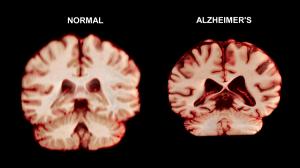
GenBio Is Pleased to Share the Latest Neuroprotective Research in Alzheimer’s disease (AD)
Crossing The Blood-Brain Barrier (BBB) The Power of Purple!
ALISO VIEJO, CA, UNITED STATES, April 25, 2025 /EINPresswire.com/ -- Alzheimer’s disease is a progressive neurodegenerative disorder where patients suffer a gradual deterioration of memory and other cognitive functions, eventually leading to complete incapacity and death. The major pathological characteristics of AD brains are the presence of senile amyloid plaques, neurofibrillary tangles, and neural loss. There is also growing evidence that oxidative stress is a key factor contributing to the initiation and progression of AD. This latest research, which is currently ongoing,
Two rare Australian natural extracts are amongst the most potent antioxidants. This is of special relevance to AD, since oxidative stress is known to be a significant factor in the AD brain. The protein known as β-amyloid (Aβ) is a key protein observed in the pathology of the AD brain. It is understood to kill cells via oxidative stress as one of its primary mechanisms.
A large body of ongoing work exists solely to unravel the pathways involved in the generation of damaging free radicals by Aβ. Whilst this peptide may be protective under certain conditions. Its overproduction in AD results in toxicity and cell death.
A growing body of evidence now supports the concept that the microbiota is a key regulator of neuroinflammation.
Dementia and cognitive impairment
Current research examines whether there are commonalities between the MOA of anthocyanins and the known physiological and biochemical changes in central nervous system disorders.
Diet is a crucial factor in influencing the gut microbiome.
Gut/Brain axis. The bi-directional communication pathways between gut bacteria (resident microbes in the GI tract and the brain) and CNS.
MOA of anthocyanins in chronic human diseases include decreased oxidative stress, inflammation, and changes in the gut microbiota. The broad commonalities between symptoms of CNS disorders and the mechanisms of therapeutic actions of anthocyanins infer that anthocyanins are potential treatments for these disorders.
Neurorestorative
Scientists at three Australian universities believe a dark purple plum bred in Queensland could help delay, or even prevent, dementia.
Researchers at the University of Wollongong, the University of Queensland, and Victoria University are testing juice from the Queen Garnet plum to see if it can protect the brain.
While each team's work is in its infancy, Victoria University's Michael Mathai says the results are very promising.
There is evidence that people with early-stage dementia or perhaps mild cognitive impairment … can be helped by this," Professor Mathai said.
"Certainly, there are some markers of inflammation which go down when they're taking plum extract."
Dr Mathai has been adding plum extract to lab-grown neuronal cells, which mimic brain cells.
"We see increases in genes or proteins made by the cells, which drive the formation of new connections and the lengthening of the axons, which are like the telephone wires that connect to the different cells … that's the basis for things like making new memories," he said.
There is a large body of evidence that the anthocyanin Queen Garnet facilitates cognitive and memory function and mood in human subjects. Recent research has investigated the plant compounds and their properties that confer these beneficial effects and studied the mechanisms through which they act on the neurons.
Recent research has now shown that QGPE treatment promotes the growth and connectivity of neurons in the brain. When considered with the existing literature that has shown that QGPE has neuroprotective effects against oxidative stress and reduction in pro-inflammatory biomarkers such as TNF-alpha, they help to explain how QGPE can improve cognitive function in people with MCI and indicate the potential for treatment and recovery from other conditions that impair cognitive function and mood.
Michael Mathai is exploring the plum's potential to protect and potentially repair damaged brain tissue.
While the research could have huge implications for the aged care sector, Professor Mathai is eager to know if the plum can also repair traumatic brain injuries. "We've already shown the extract will protect against chemically induced damage from oxidative stress, for example, that's a neuroprotection area, but … will it help to repair already damaged tissue? That's something which we need to investigate further," he said.
In Brisbane, Yasmina Sultanbawa says the Queen Garnet plum's high levels of anthocyanins, a compound found in purple, blue and some red fruit and vegetables, may explain its potential to improve brain health.
Anthocyanins are known for their antioxidant and anti-inflammatory properties. Studies suggest they help reduce blood pressure, delay diabetes and support heart health.
Todd D. Sonoga
GenBio Inc.
+1 949-705-8021
email us here
Visit us on social media:
LinkedIn
Facebook
X
GenBio Inc Elevator Pitch
Distribution channels: Banking, Finance & Investment Industry, Conferences & Trade Fairs, Food & Beverage Industry, Healthcare & Pharmaceuticals Industry, Science
Legal Disclaimer:
EIN Presswire provides this news content "as is" without warranty of any kind. We do not accept any responsibility or liability for the accuracy, content, images, videos, licenses, completeness, legality, or reliability of the information contained in this article. If you have any complaints or copyright issues related to this article, kindly contact the author above.
Submit your press release

